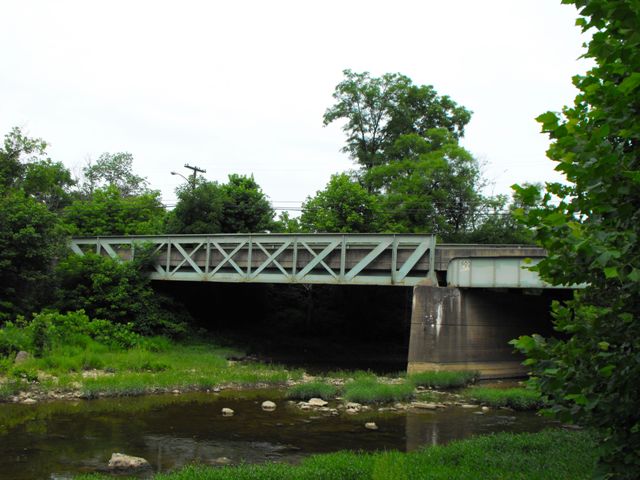We Recommend:
Bach Steel - Experts at historic truss bridge restoration.
BridgeHunter.com Phase 1 is released to the public! - Visit Now
Clarksville Bridge

Primary Photographer(s): Nathan Holth and Rick McOmber
Bridge Documented: July 10, 2009
1944
83.0 Feet (25.3 Meters)
151.0 Feet (46 Meters)
24 Feet (7.32 Meters)
1 Main Span(s) and 1 Approach Span(s)
30101101500501

View Information About HSR Ratings
Bridge Documentation
This bridge's future is at risk!
View Archived National Bridge Inventory Report - Has Additional Details and Evaluation
This bridge's unusual plate-like trusses give the bridge away as a bridge that used to carry or cross a railroad line. Railroads had a habit of occasionally designing truss bridges with members that have a flat plate-like quality to them. This bridge is very plate line, and indeed the diagonal members on this bridge are plates. This design is unusual because it is one that was only used by the railroads and even there only occasionally. The design of this bridge is similar to a railroad bridge in Michigan.
The bridge also features through plate girder approach spans.
The historic bridge inventory below seems ignorant to the above facts and as such, HistoricBridges.org disagrees with the below non-historic determination. However, HistoricBridges.org does agree with their comments that this bridge may date to the late 1800s. The railroad bridges built rigid rivet-connected truss bridges at an earlier date than highway bridge builders.
Information and Findings From Pennsylvania's Historic Bridge InventoryDiscussion of Bridge The skewed, 2 span, 151' long and 29.5' wide bridge consists of a thru girder main span over the channel and a Pratt truss approach span. The bridge is dated 1944, and the truss is an older span that was relocated and cut down considerably to fit (cut marks are visible on one end). It could date to the late 19th century and have been a rail-carrying facility. It is ill proportioned for its length because it was originally a much longer and thus necessarily deeper, span. Its original location is not known. A pedestrian sidewalk with a 3 high welded metal channel railing is cantilevered off the upstream elevation. The substructure consists of concrete abutments with wingwalls and a concrete pier. The safety shape barriers were placed in 1983. The bridge is not historically or technologically significant. Discussion of Surrounding Area The bridge carries a 2 lane street over a stream in Clarksville. East of the bridge is an area of altered early to mid 20th century vernacular housing. West of the bridge the housing appears to thin out to scattered, predominantly post-World War II residences. The area does not appear to have historic district potential. Bridge Considered Historic By Survey: No |
![]()
Photo Galleries and Videos: Clarksville Bridge
Bridge Photo-Documentation
Original / Full Size PhotosA collection of overview and detail photos. This gallery offers photos in the highest available resolution and file size in a touch-friendly popup viewer.
Alternatively, Browse Without Using Viewer
![]()
Bridge Photo-Documentation
Mobile Optimized PhotosA collection of overview and detail photos. This gallery features data-friendly, fast-loading photos in a touch-friendly popup viewer.
Alternatively, Browse Without Using Viewer
![]()
Maps and Links: Clarksville Bridge
Coordinates (Latitude, Longitude):
Search For Additional Bridge Listings:
Bridgehunter.com: View listed bridges within 0.5 miles (0.8 kilometers) of this bridge.
Bridgehunter.com: View listed bridges within 10 miles (16 kilometers) of this bridge.
Additional Maps:
Google Streetview (If Available)
GeoHack (Additional Links and Coordinates)
Apple Maps (Via DuckDuckGo Search)
Apple Maps (Apple devices only)
Android: Open Location In Your Map or GPS App
Flickr Gallery (Find Nearby Photos)
Wikimedia Commons (Find Nearby Photos)
Directions Via Sygic For Android
Directions Via Sygic For iOS and Android Dolphin Browser
USGS National Map (United States Only)
Historical USGS Topo Maps (United States Only)
Historic Aerials (United States Only)
CalTopo Maps (United States Only)

